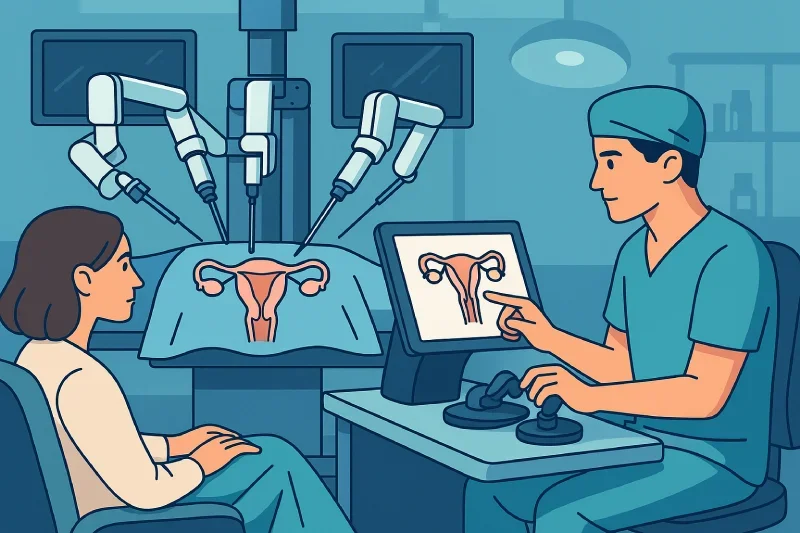What is the Success Rate of Tubal Reversal Surgery in Burleson, TX?
Categories:
By: Ethan Cole
Tubal reversal in Burleson, TX, while offering the possibility of natural conception, carries risks like any surgical procedure—bleeding, infection, anesthesia complications, and an increased risk of ectopic pregnancy. On average, Fort Worth–area fertility centers report that 40–85 % of women conceive within two years after reversal surgery. Exact success rates hinge on age, the remaining length of the fallopian tube after repair, sperm quality from the woman’s partner or a sperm donor, and the surgeon’s microsurgical skill set. Below, we expand on the numbers, the factors that push them up or down, and practical steps to tip the odds in your favor.
Key Takeaways for Women and Couples Considering Tubal Reversal or IVF
Success rates range from roughly 75 % in patients under 30 to about 30 % in patients over 40. Egg quality declines and tubal length shortens with age, so an early consultation with local fertility specialists is critical.
Microsurgical experience matters. Surgeons in Burleson who perform 100 + reversals a year, often using the da Vinci Surgical System or high-power microscopes, report higher live-birth rates and fewer complications than low-volume providers.
Residual tubal length of 4 cm or more delivers the best chance of pregnancy; shorter tubes lower success rates and increase ectopic risk to 5–10 %.
Cost per live birth can be lower than IVF because one reversal procedure allows unlimited conception attempts, whereas IVF is a pay-per-cycle fertility treatment.
Lifestyle changes—healthy BMI, no smoking, folate supplementation, male factor optimization—can raise personal pregnancy success by up to 15 %.
Expect a two-week physical recovery and a six-week wait before trying to conceive, followed by an early ultrasound at 5–6 weeks gestation to rule out ectopic pregnancy.
How Fertility Surgeons Calculate Tubal Reversal Success Rates in Burleson
Burleson, Austin, and Fort Worth fertility specialists blend national data with clinic-specific numbers to quote your probability of conceiving naturally. They review:
Age and ovarian reserve labs (AMH, FSH)
Remaining portion of the tube after tubal ligation surgery
Sperm analysis from the woman’s partner or a sperm donor
Surgical reports describing the method of tubal ligation (clips, rings, Pomeroy, Filshie, cautery)
Success by Age and Tube Length
|
Age Group |
Average Tube Length After Repair |
Pregnancy Rate (24 mo) |
Live-Birth Rate |
Ectopic Risk |
|
< 30 |
≥ 5 cm |
80 % |
75 % |
3 % |
|
30–34 |
4–5 cm |
70 % |
65 % |
5 % |
|
35–39 |
3–4 cm |
55 % |
48 % |
7 % |
|
≥ 40 |
< 3 cm |
35 % |
30 % |
10 % |
Surgeon Volume and Facility Data
High-volume fertility surgeons skilled in microsurgical techniques, mini-laparotomy, or laparoscopic reconstruction of the fallopian tubes report 10–15 % higher pregnancy rates than occasional operators. Ask how many reversals a year your clinic performs, what percentage result in live births, and whether advanced robotics or laparoscopy will be used.
Beyond Numbers: Partner and Embryo Factors
Roughly 30 % of failed post-reversal attempts trace back to undiagnosed male-factor infertility. A basic semen analysis clarifies sperm count, motility, and DNA integrity. Healthy sperm pairs with good tubal patency to form high-quality embryos that implant in the uterus.
Tubal Reversal vs. IVF: Which Fertility Treatment Fits Your Family Plan?
Both tubal reversal and in vitro fertilization (IVF) aim for pregnancy, but their timelines, costs, and emotional tolls differ. Mapping these differences helps you decide where to invest money and hope.
Cost and Insurance
Out-of-pocket expense for tubal reversal in Burleson averages $6,000–$9,000. This typically covers anesthesia, outpatient facility fees, and surgeon time. By contrast, one IVF cycle often exceeds $14,000–$18,000 after medication, egg retrieval procedure, embryo culture, and embryo transfer. Insurance rarely covers either option, although some plans in Texas offer partial IVF benefit riders.
Time to Pregnancy and Live Birth
A successful tubal reversal restores ongoing fertility—one surgical event but unlimited natural attempts. Cumulative chances can surpass IVF over two years if tubes remain open. However, IVF may be faster if you’re over 40, have short residual tubes, or carry additional infertility diagnoses. Egg retrieval bypasses damaged tubes and allows genetic testing before transferring one healthy embryo, a strategy linked to higher pregnancy rates per transfer.
Emotional Considerations
Many patients value conceiving at home without injections, egg retrievals, or lab protocols. Others appreciate IVF’s controlled timing and embryo monitoring. Counseling patients individually helps align treatment with life circumstances.
Worth Fertility or Austin Fertility Surgeons—Why Geography Matters
Proximity affects monitoring visits. If you live closer to Fort Worth Fertility Center, daily ultrasounds during IVF may be convenient. If you’re in Burleson, an outpatient mini-laparotomy for reversal may save commuting time and money.
Understanding the Tubal Reversal Surgical Procedure Step by Step
Knowing exactly what happens in the OR reduces anxiety.
Pre-operative Assessment
You’ll complete bloodwork (AMH, FSH, estradiol), a hysterosalpingogram to outline tubal anatomy, and transvaginal ultrasound to count follicles. Smoking cessation, BMI optimization, and vitamin D correction prepare your uterine lining for implantation post-surgery.
Anesthesia and Incision
Under general anesthesia, a 4- to 6-cm bikini-line incision is made for mini-laparotomy, or three 5-mm ports for laparoscopy. The ligated ends of the fallopian tube are surgically removed at the scarred segment to reveal healthy tissue.
Microsurgical Techniques
Using 8-0 or 9-0 sutures under an operating microscope—or the da Vinci Surgical System for robotic precision—the surgeon aligns the inner tubal lumen. A leak test with dye confirms tubal patency. Total operative time averages one to two hours, and most women go home the same day.
Recovery Timeline
Expect to walk the next morning but avoid lifting over 10 lbs for two weeks. Many return to work within seven to ten days if duties are sedentary. You can resume exercise at four weeks and start trying to conceive after your six-week post-op clearance.
Risks Associated with Tubal Reversal and How Local Clinics Minimize Them
Every form of birth control reversal carries inherent danger, but modern protocols keep complication rates low.
Common Complications
Bleeding, infection, or anesthesia reactions (under 2 %)
Ectopic pregnancy (5–10 % following reversal)
Scar tissue formation causing tubal blockage
Early ultrasound at six weeks gestation catches ectopic implantation before rupture.
Safety Protocols
Burleson facilities use board-certified anesthesiologists, sterile laminar airflow suites, prophylactic antibiotics, and leak-proof closures to keep infection below 1 %. Some clinics add robotic articulation to shorten incision length, speeding recovery.
When to Call Your Doctor
Fever over 100.4 °F
Worsening abdominal pain after day three
Bright-red vaginal bleeding or foul discharge
Positive pregnancy test with shoulder-tip pain (possible ectopic)
Preparing for Success: Lifestyle and Medical Steps Before Your Reversal Procedure
Small habit shifts today can add percentage points to tomorrow’s pregnancy test.
Lab Tests and Imaging
In addition to fertility labs, many surgeons request a thyroid panel, HbA1c, and vitamin D level. Correcting thyroid or glucose issues improves uterine receptivity and embryo implantation.
Optimizing Fertility Health
Maintain a BMI of 19–25 to balance hormones.
Quit smoking three months prior; nicotine constricts blood vessels feeding the ends of the fallopian tube.
Take 800 mcg folic acid daily to lower neural-tube defects and support embryonic cell division.
Limit alcohol to four drinks weekly; heavy intake lowers IVF and reversal pregnancy success alike.
Partner Factors
Have your partner:
Obtain a semen analysis.
Start antioxidants like vitamin C, vitamin E, zinc, and CoQ10.
Avoid hot tubs and tight underwear for cooler scrotal temperatures.
Healthier sperm pair with healthy eggs to yield embryos that develop into full-term pregnancies.
What to Expect After Surgery: Tracking Fertility and When to Seek Help
Early Pregnancy Testing
Begin trying to conceive after your six-week clearance. Home pregnancy tests 14 days post-ovulation allow prompt prenatal care. If positive, schedule ultrasound at 5–6 weeks to confirm intra-uterine implantation.
When IVF Becomes Plan B
If no pregnancy occurs by 12 months (under age 35) or six months (over 35), consider IVF. A repeat hysterosalpingogram can confirm tubal patency; if blocked or age-related egg decline is present, IVF or another effective fertility treatment may be wiser.
Support Networks in North Texas
Groups like DFW Fertility Warriors and church-based couples’ circles provide community. Stress hormones such as cortisol can impair implantation, so emotional support is an often-overlooked fertility booster.
Conclusion: Choosing Between Tubal Reversal and In Vitro Fertilization
Tubal reversal in Burleson can be a cost-effective, emotionally satisfying route to natural conception. Success depends on age, tube length, surgeon volume, sperm quality, and lifestyle choices you can control. By partnering with an experienced microsurgical team, maintaining optimal health, and monitoring early pregnancies carefully, you can push your personal pregnancy rate toward the top of published ranges. Ready to explore your chances? Book a consultation with a qualified Burleson fertility specialist, bring your questions, and craft a plan that puts you back on the path to parenthood.
Schedule your tubal reversal consultation today
Call (817) 568-8731Categories:
Frequently Asked Questions
-
Most fertility surgeons recommend waiting six weeks to allow complete healing of the incision and reconstruction of the fallopian tubes. This interval also lets your uterine lining recover from anesthesia medications. After clearance, you can attempt natural conception every cycle without restrictions.
-
A hysterosalpingogram uses X-ray dye to confirm tubal patency. Mild cramping may occur for one to two minutes as dye enters the uterus and tubes, but over-the-counter pain relievers ease discomfort. The test reassures both patient and surgeon that the reversal restored an open path for sperm to meet the egg.
-
Success rates are similar when performed by high-volume fertility specialists. Robotic and laparoscopic methods use smaller incisions and may shorten recovery, but they cost more. Mini-laparotomy offers direct visualization of the tube and remains the gold standard in many centers.
-
Male-factor infertility can be treated with lifestyle changes, medications, or intrauterine insemination (IUI). If counts remain very low, combining tubal reversal with IVF attempts—where a single sperm is injected into each mature egg—can still produce embryos that develop and lead to live birth.
-
Yes. The ovaries remain fully accessible for IVF even after you’ve had a successful tubal reversal procedure. Egg retrieval simply bypasses the tubes, so a prior reversal does not complicate or prevent the process of IVF later on.
-
Reversal surgery reconnects tubal ends but does not alter ovarian hormone production, so cycle length and flow usually remain the same. Some women notice lighter periods temporarily because of postoperative anti-inflammatory medications, but normal patterns return within two to three months.
-
If you aim for multiple pregnancies, reversal often proves cheaper than repeated IVF cycles. Once patency is restored, you avoid future retrieval, laboratory, and embryo transfer fees, making the overall cost per live birth lower for many couples.
-
Watch for sharp pelvic pain, one-sided discomfort, shoulder-tip pain, or lightheadedness with a positive pregnancy test. Seek emergency care immediately; early ultrasound and bloodwork can confirm location and allow prompt treatment, preserving your tube and future fertility.
-
Yes, although uncommon. Scar tissue or infection can re-block the lumen months or years later. Maintaining a healthy BMI, avoiding pelvic infections, and scheduling follow-up imaging if pregnancy hasn’t occurred within a year help detect and address re-occlusion early.
-
Cautery-based ligations remove more tissue, often leaving a short residual segment. If final projected tube length is under 3 cm, IVF offers higher pregnancy success rates. A consultation with a fertility center experienced in both reversal and in vitro fertilization will clarify which path yields better odds for you.













